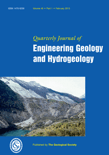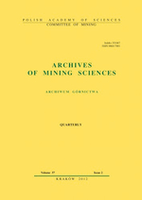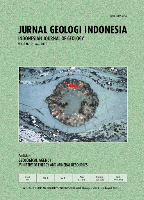
Quarterly Journal of Engineering Geology and Hydrogeology
Scope & Guideline
Bridging Theory and Practice in Earth Sciences.
Introduction
Aims and Scopes
- Geotechnical Engineering:
Research on the mechanical properties of geological materials, stability analysis of structures, and the effects of geological conditions on engineering projects. - Hydrogeology:
Studies related to groundwater flow, aquifer characterization, and the impacts of human activities and climate change on water resources. - Environmental Geology:
Investigations into the effects of geological processes on the environment, including contamination, remediation strategies, and sustainable management of natural resources. - Natural Hazards and Risk Assessment:
Research focused on geohazards such as landslides, earthquakes, and flooding, including risk assessment and mitigation strategies. - Geostatistics and Modeling:
Application of statistical methods and modeling techniques to analyze geological and hydrogeological data for better predictions and decision-making. - Innovations in Geoscience:
Exploration of new methodologies, technologies, and materials that enhance the understanding and application of geoscience in engineering contexts.
Trending and Emerging
- Climate Change Impacts:
An increasing number of studies address the effects of climate change on geological and hydrogeological processes, including groundwater resource management and engineering resilience. - Sustainable Engineering Practices:
Research focusing on sustainable materials and methods in engineering geology, such as the use of recycled materials and eco-friendly stabilization techniques, is on the rise. - Advanced Modeling Techniques:
The emergence of sophisticated modeling approaches, including machine learning and artificial intelligence, is transforming how researchers analyze geological data and predict behavior. - Geothermal Energy Applications:
A growing interest in geothermal energy as a sustainable resource is evident, with more studies exploring its potential and the geological factors influencing its feasibility. - Integrated Water Resource Management:
There is a trend towards comprehensive studies that integrate hydrological, geological, and environmental perspectives for effective water resource management. - Geohazard Mitigation Strategies:
Research on innovative strategies for mitigating geohazards, particularly in urban environments, is becoming increasingly prominent, reflecting the need for resilient infrastructure.
Declining or Waning
- Traditional Geotechnical Testing Methods:
There is a noticeable decrease in studies solely focused on conventional geotechnical testing methods, as more researchers turn to advanced technologies and computational techniques. - Static Models in Hydrogeology:
Research utilizing static models for groundwater flow and contaminant transport is becoming less frequent, with a shift towards dynamic and integrated modeling approaches. - Historical Geological Studies:
Papers focused on purely historical geological analyses without current applications or implications have decreased, as the journal emphasizes relevance to contemporary engineering challenges. - Single-Factor Risk Assessments:
The trend is moving away from assessments that consider singular factors in risk analysis towards more integrated approaches that account for multiple interacting variables. - Local Case Studies with Limited Scope:
There is less emphasis on localized case studies that do not provide broader insights or implications for the field, as the journal seeks to publish more globally relevant research.
Similar Journals

Bulletin of Engineering Geology and the Environment
Transforming challenges into solutions in engineering geology.Bulletin of Engineering Geology and the Environment, published by SPRINGER HEIDELBERG, is a leading journal dedicated to the fields of Geology, Geotechnical Engineering, and Engineering Geology. With an impressive impact factor placing it in the Q1 category for both geology and geotechnical disciplines, this journal is recognized for its significant contributions to the knowledge and application of engineering geology practices. Since its inception in 1984, the Bulletin has provided a platform for researchers and professionals to share cutting-edge research, case studies, and innovative methodologies relevant to the challenges of understanding and managing geological environments. With a robust Scopus ranking—#32/321 in Geology and #43/229 in Geotechnical Engineering—this journal is an essential resource for academics and industry leaders alike, striving to advance the environmental engineering field. For those interested in accessing the latest research and developments, the Bulletin fosters a collaborative and informed scholarly community.

Geodynamics
Transforming Geosciences Through Open AccessGeodynamics is an emerging scholarly journal published by LVIV POLYTECHNIC NATIONAL UNIVERSITY, dedicated to advancing knowledge in the fields of Earth and Planetary Sciences, with a particular emphasis on Geophysics, Geology, and related specialties. Featuring both ISSN 1992-142X and E-ISSN 2519-2663, this journal aims to publish high-quality research that addresses critical challenges in geodynamic processes and their implications on our planet's systems. Despite its nascent status, having converged years from 2023 to 2024, Geodynamics is poised to attract attention in the academic community, especially as evidenced by its rankings in Scopus, which position it prominently within the discipline. The journal's commitment to open access ensures that cutting-edge research is readily available to the global scientific community, fostering collaboration and innovation. Researchers, professionals, and students will find Geodynamics an essential resource for the latest findings and discussions in geodynamics and related fields, making it an invaluable addition to the landscape of environmental science journals.

DOKLADY EARTH SCIENCES
Advancing Knowledge in Earth and Planetary SciencesDOKLADY EARTH SCIENCES is a reputable journal published by MAIK NAUKA/INTERPERIODICA/SPRINGER, focusing on the dynamic field of Earth and Planetary Sciences. With an ISSN of 1028-334X and E-ISSN 1531-8354, this journal offers a platform for researchers to disseminate their findings and insights that contribute to our understanding of Earth systems over a continuous publishing span from 1998 to 2024. It currently holds a Q3 quartile ranking in the Earth and Planetary Sciences category, reflecting an emerging yet significant impact within its field, evidenced by its Scopus ranks where it stands at 123rd in general Earth sciences and 113th in miscellaneous Earth sciences. DOKLADY EARTH SCIENCES aims to bridge research gaps and foster collaboration among a diverse audience including researchers, professionals, and students committed to advancing knowledge in geoscience. The journal stands as a vital resource for those seeking to explore contemporary challenges and innovations within the realm of Earth sciences.

Journal of Earth Science
Connecting global minds through open access geoscience.Journal of Earth Science, published by the China University of Geosciences, Wuhan, is a leading journal in the field of Earth and Planetary Sciences, recognized for its significant contributions to the understanding of geological processes and environmental challenges. With an impressive Q1 ranking among Earth and Planetary Sciences journals and a strong position at Rank #39/195 in Scopus, this journal not only showcases high-quality research but also serves as a crucial platform for disseminating innovative findings, spanning a broad spectrum of topics from geophysics to climate change. The journal adopts an open access model, which enhances the visibility and accessibility of research articles published from 2009 to 2024, thereby facilitating collaboration and knowledge sharing among the global scientific community. With its commitment to advancing geosciences, Journal of Earth Science is invaluable for researchers, professionals, and students alike, eager to stay informed and contribute to ongoing discussions in this dynamic field.

Carpathian Journal of Earth and Environmental Sciences
Exploring the Interplay of Geology and EnvironmentCarpathian Journal of Earth and Environmental Sciences is a distinguished academic journal dedicated to advancing the interdisciplinary field of Earth and environmental sciences. Published by the Carpathian Association for Environment and Earth Sciences, this journal plays a pivotal role in disseminating high-quality research focused on the dynamic interactions between geological processes and environmental changes. With an ISSN of 1842-4090 and an E-ISSN of 1844-489X, the journal is indexed in Scopus and holds an esteemed Q3 quartile ranking in both Earth and Planetary Sciences and Environmental Science categories as of 2023. Since its inception in 2008, the Carpathian Journal has provided an open access platform for researchers, professionals, and students to share insights, foster collaboration, and engage in critical discussions on pressing environmental issues. By continuously contributing to the body of knowledge in this field, the journal not only enhances academic discourse but also promotes sustainable environmental practices across Romania and beyond.

Journal of Himalayan Earth Sciences
Illuminating the Earth's Processes in the Himalayan RegionThe Journal of Himalayan Earth Sciences (ISSN: 1994-3237; E-ISSN: 2305-6959) is a distinguished publication by UNIV PESHAWAR, dedicated to advancing knowledge in the field of earth sciences, particularly as they relate to the Himalayan region. Established in 2013, this journal aims to provide a platform for researchers, professionals, and students to share original research findings, reviews, and innovative methodologies that contribute to the understanding of geological and environmental phenomena in this ecologically significant area. Despite being categorized in Q4 of the Earth and Planetary Sciences, the journal showcases valuable contributions to the scientific community and encourages submissions that delve into both the challenges and advancements within Earth sciences, with a particular focus on the unique geological structures and processes of the Himalayas. As an open-access journal, it ensures that research is accessible to a global readership, promoting collaboration and discussion among scholars and practitioners. The journal's operational base in Peshawar, Pakistan, places it at the heart of Himalayan research, making it an invaluable resource for those invested in earth sciences.

Geam-Geoingegneria Ambientale e Mineraria-Geam-Geoengineering Environment and Mining
Pioneering research at the intersection of earth science and sustainability.Geam-Geoingegneria Ambientale e Mineraria (Geam-Geoengineering Environment and Mining), published by PATRON EDITORE S R L in Italy, is a pivotal journal dedicated to the intersection of environmental engineering, geotechnical engineering, and engineering geology. With an ISSN of 1121-9041, this journal has been a key source of valuable research since 2007, fostering the dissemination of knowledge within these critical fields. Despite its current ranking in the Q4 category for both Environmental Engineering and Geotechnical Engineering in 2023, the journal aims to elevate its standing by promoting high-quality submissions that address pressing issues related to sustainable geoengineering practices and environmental impacts of mining activities. Although not an open-access journal, Geam-Geoingegneria Ambientale e Mineraria offers insights that are crucial for professionals, researchers, and students looking to contribute to the advancement of geoengineering approaches and their implications for both the environment and mining industries. As it continues to bridge theoretical frameworks with practical applications, the journal stands as an important avenue for scholarly discourse and innovation in these domains.

Geosfernye Issledovaniya-Geosphere Research
Connecting Researchers for a Greener FutureGeosfernye Issledovaniya-Geosphere Research, published by TOMSK STATE UNIVERSITY, is a significant addition to the scholarly discourse within the fields of Earth and Planetary Sciences, Ecology, and Geography. With a focus on innovative research and insights that span a broad spectrum of environmental and geographical studies, this journal aims to provide a platform for researchers and students alike to disseminate their findings and discuss pressing issues facing our planet. Though classified in the Q4 quartile for its 2023 metrics, it serves as an important venue for early-career scientists and scholars from the Russian Federation and beyond to contribute to the global dialogue surrounding geosciences. The journal operates with various access options, making it accessible to a diverse audience. It encourages submissions that inspire robust discussion and exploration of topics vital to our understanding of the geosphere and its intricate dynamics. Covering the pivotal years from 2019 to 2024, Geosfernye Issledovaniya-Geosphere Research is poised to enhance its relevancy and impact within the academic community.

Archives of Mining Sciences
Advancing knowledge in mining and geology.Archives of Mining Sciences is a peer-reviewed journal published by the Polska Akademia Nauk (Polish Academy of Sciences), dedicated to advancing knowledge in the fields of geochemistry, petrology, geotechnical engineering, and engineering geology. With an ISSN of 0860-7001 and an E-ISSN of 1689-0469, this journal has been a vital resource for professionals and researchers since its inception in 1991. Housed in Poland, the journal serves as a platform for the dissemination of significant research results, technical developments, and case studies, ensuring accessibility to a global audience. Competing in a rigorous landscape, it has achieved a notable Q3 ranking in 2023 within both the Geochemistry and Petrology and Geotechnical Engineering and Engineering Geology categories. As it converges through its years of publication—currently covering the period from 2008 to 2024—the journal maintains a strong focus on fostering innovative research that addresses crucial geological challenges. Its presence in Scopus rankings reinforces its commitment to quality and relevance, making it an essential read for students and professionals seeking to stay at the forefront of mining sciences.

Indonesian Journal of Geoscience
Pioneering Research in Geoscience for Global Impact.Indonesian Journal of Geoscience, published by the GEOLOGICAL AGENCY, is a vital platform for sharing cutting-edge research in the field of Earth and Planetary Sciences. With an ISSN of 2355-9314 and E-ISSN of 2355-9306, this open-access journal has been making significant contributions to the geoscientific community since its establishment in 2013. Operating out of Bandung, Indonesia, the journal is dedicated to disseminating high-quality research across diverse areas, making it an essential resource for researchers, professionals, and students alike. Recognized in the 2023 Q2 category in Earth and Planetary Sciences, it currently ranks #134/195 among general Earth and Planetary Sciences journals in Scopus, reflecting its growing prominence and academic rigor. The journal seeks to foster scientific discussions by publishing original research, reviews, and case studies that address contemporary challenges and advancements in geoscience, thus contributing to a deeper understanding of our planet. With its commitment to open access, the Indonesian Journal of Geoscience ensures that vital research is accessible to a global audience, encouraging collaboration and innovation in the field.